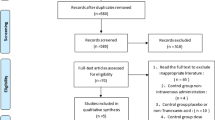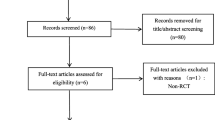Abstract
Background
Studies have shown that tranexamic acid reduces blood loss and transfusion need in patients undergoing total hip arthroplasty. However, no to date, no study has been large enough to determine definitively whether the drug is safe and effective. We examined whether intravenous tranexamic acid, when compared with placebo, was safe and effective in total hip arthroplasty.
Methods
The literature search was conducted using the PubMed, Cochrane Library, MEDLINE, EMBASE, and China National Knowledge Infrastructure (CNKI) databases. Data were evaluated using the generic evaluation tool designed by the Cochrane Bone, Joint and Muscle Trauma Group. Ultimately, 19 randomized controlled trials involving 1,030 patients were included.
Results
The use of tranexamic acid significantly reduced total blood loss by a mean of 305.27 mL [95 % confidence interval (CI) −397.66 to −212.89, p < 0.001], intraoperative blood loss by a mean of 86.33 mL(95 % CI −152.29 to −20.37, p = 0.01), postoperative blood loss by a mean of 176.79 mL (95 % CI −236.78 to −116.39, p < 0.001), and “hidden” blood loss by a mean of 152.70 mL (95 % CI −187.98 to −117.42, p < 0.001), resulting in a meaningful reduction in the proportion of patients requiring blood transfusion (odds ratio 0.28, 95 % CI 0.19 to 0.42, p < 0.001). There was no significant difference in occurrence of deep vein thrombosis, pulmonary embolism, or other complications among the study groups, or cost or hospitalization duration.
Conclusions
The data from this meta-analysis indicate that intravenous tranexamic acid may reduce blood loss and transfusion need in patients undergoing total hip arthroplasty without increasing the risk of complications. However, high-quality randomized controlled trials are required to validate the results.









Similar content being viewed by others
References
Kurtz S, Ong K, Lau E, Mowat F, Halpern M (2007) Projections of primary and revision hip and knee arthroplasty in the United States from 2005 to 2030. J Bone Joint Surg Am 89:780–785
Kumar A (2009) Perioperative management of anemia: limits of blood transfusion and alternatives to it. Clevel Clin J Med 76(Suppl 4):S112–S118
Lemaire R (2008) Strategies for blood management in orthopaedic and trauma surgery. J Bone Joint Surg Br 90:1128–1136
Hill GE, Frawley WH, Griffith KE, Forestner JE, Minei JP (2003) Allogeneic blood transfusion increases the risk of postoperative bacterial infection: a meta-analysis. J Trauma 54:908–914
Cardone D, Klein AA (2009) Perioperative blood conservation. Eur J Anaesthesiol 26:722–729
Henry DA, Carless PA, Moxey AJ et al. (2002) Pre-operative autologous donation for minimising perioperative allogeneic blood transfusion. Cochrane Database Syst Rev CD003602
Carless PA, Henry DA, Moxey AJ, O’Connell D, Brown T, Fergusson DA (2010) Cell salvage for minimising perioperative allogeneic blood transfusion. Cochrane Database Syst Rev CD001888
Dhawale AA, Shah SA, Sponseller PD et al (2012) Are antifibrinolytics helpful in decreasing blood loss and transfusions during spinal fusion surgery in children with cerebral palsy scoliosis? Spine 37:E549–E555
Ekback G, Axelsson K, Ryttberg L et al (2000) Tranexamic acid reduces blood loss in total hip replacement surgery. Anesth Analg 91:1124–1130
Ido K, Neo M, Asada Y et al (2000) Reduction of blood loss using tranexamic acid in total knee and hip arthroplasties. Arch Orthop Trauma Surg 120:518–520
Benoni G, Fredin H, Knebel R, Nilsson P (2001) Blood conservation with tranexamic acid in total hip arthroplasty: a randomized, double-blind study in 40 primary operations. Acta Orthop Scand 72:442–448
Husted H, Blond L, Sonne-Holm S, Holm G, Jacobsen TW, Gebuhr P (2003) Tranexamic acid reduces blood loss and blood transfusions in primary total hip arthroplasty: a prospective randomized double-blind study in 40 patients. Acta Orthop Scand 74:665–669
Lemay E, Guay J, Cote C, Roy A (2004) Tranexamic acid reduces the need for allogenic red blood cell transfusions in patients undergoing total hip replacement. Can J Anaesth 51:31–37
Yamasaki S, Masuhara K, Fuji T (2004) Tranexamic acid reduces blood loss after cementless total hip arthroplasty-prospective randomized study in 40 cases. Int Orthop 28:69–73
Johansson T, Pettersson LG, Lisander B (2005) Tranexamic acid in total hip arthroplasty saves blood and money: a randomized, double-blind study in 100 patients. Acta Orthop 76:314–319
Niskanen RO, Korkala OL (2005) Tranexamic acid reduces blood loss in cemented hip arthroplasty: a randomized, double-blind study of 39 patients with osteoarthritis. Acta Orthop 76:829–832
Claeys MA, Vermeersch N, Haentjens P (2007) Reduction of blood loss with tranexamic acid in primary total hip replacement surgery. Acta Chir Belg 107:397–401
Kazemi SM, Mosaffa F, Eajazi A et al (2010) The effect of tranexamic acid on reducing blood loss in cementless total hip arthroplasty under epidural anesthesia. Orthopedics 33:17
Singh J, Ballal MS, Mitchell P, Denn PG (2010) Effects of tranexamic acid on blood loss during total hip arthroplasty. J Orthop Surg 18:282–286
McConnell JS, Shewale S, Munro NA, Shah K, Deakin AH, Kinninmonth AW (2011) Reduction of blood loss in primary hip arthroplasty with tranexamic acid or fibrin spray. Acta Orthop 82:660–663
Malhotra R, Kumar V, Garg B (2010) The use of tranexamic acid to reduce blood loss in primary cementless total hip arthroplasty. Eur J Orthop Surg Traumatol 21:101–104
Clave A, Fazilleau F, Dumser D, Lacroix J (2012) Efficacy of tranexamic acid on blood loss after primary cementless total hip replacement with rivaroxaban thromboprophylaxis: a case-control study in 70 patients. Orthop Traumatol Surg Res 98:484–490
Hai FZZJY (2012) Effect of tranexamic acid on the hidden blood loss after total hip arthroplasty. J Chongqing Med Univ 37(4):359
Imai N, Dohmae Y, Suda K, Miyasaka D, Ito T, Endo N (2012) Tranexamic Acid for reduction of blood loss during total hip arthroplasty. J Arthroplasty 27:1838–1843
Moher D, Liberati A, Tetzlaff J, Altman DG, Group P (2009) Preferred reporting items for systematic reviews and meta-analyses: the PRISMA statement. BMJ 339:b2535
Sehat KR, Evans RL, Newman JH (2004) Hidden blood loss following hip and knee arthroplasty. Correct management of blood loss should take hidden loss into account. J Bone Joint Surg Br 86:561–565
Handoll HH, Gillespie WJ, Gillespie LD, Madhok R (2007) Moving towards evidence-based healthcare for musculoskeletal injuries: featuring the work of the Cochrane Bone, joint and Muscle Trauma Group. J R Soc Promot Health 127:168–173
Higgins JP, Thompson SG (2002) Quantifying heterogeneity in a meta-analysis. Stat Med 21:1539–1558
Sukeik M, Alshryda S, Haddad FS, Mason JM (2011) Systematic review and meta-analysis of the use of tranexamic acid in total hip replacement. J Bone Joint Surg Br 93:39–46
Benoni G, Lethagen S, Nilsson P, Fredin H (2000) Tranexamic acid, given at the end of the operation, does not reduce postoperative blood loss in hip arthroplasty. Acta Orthop Scand 71:250–254
Garneti N, Field J (2004) Bone bleeding during total hip arthroplasty after administration of tranexamic acid. J Arthroplasty 19:488–492
Rajesparan K, Biant LC, Ahmad M, Field RE (2009) The effect of an intravenous bolus of tranexamic acid on blood loss in total hip replacement. J Bone Joint Surg Br 91:776–783
McCormack PL (2012) Tranexamic acid: a review of its use in the treatment of hyperfibrinolysis. Drugs 72:585–617
Conflict of interest
The authors declare that they have no conflict of interest.
Author information
Authors and Affiliations
Corresponding author
Rights and permissions
About this article
Cite this article
Zhou, Xd., Tao, Lj., Li, J. et al. Do we really need tranexamic acid in total hip arthroplasty? A meta-analysis of nineteen randomized controlled trials. Arch Orthop Trauma Surg 133, 1017–1027 (2013). https://doi.org/10.1007/s00402-013-1761-2
Received:
Published:
Issue Date:
DOI: https://doi.org/10.1007/s00402-013-1761-2




